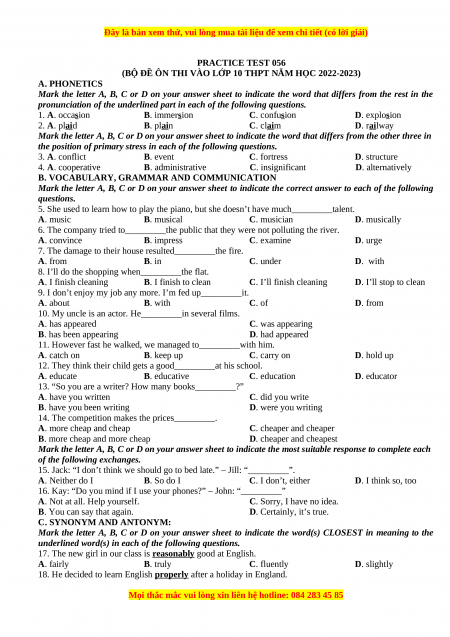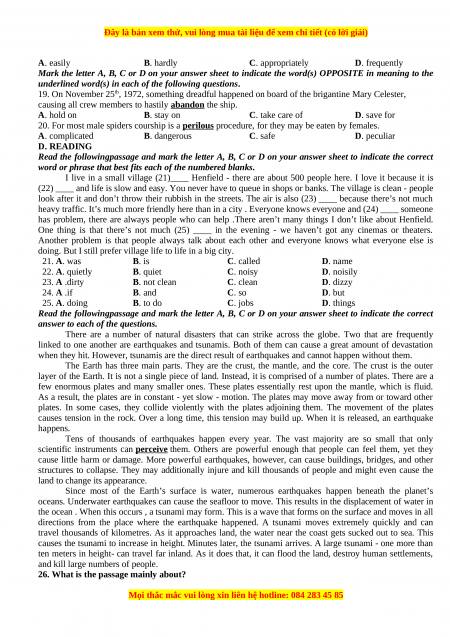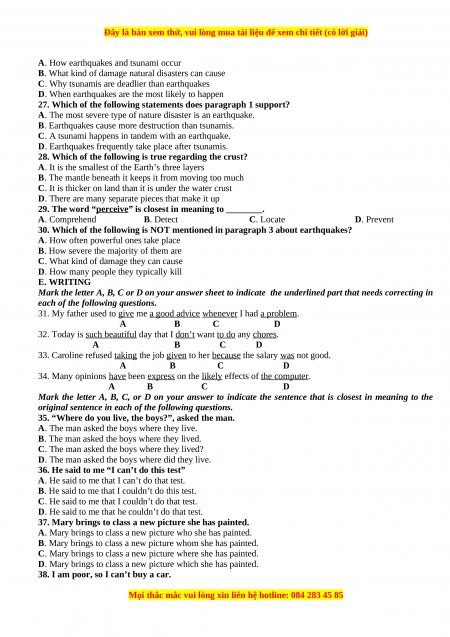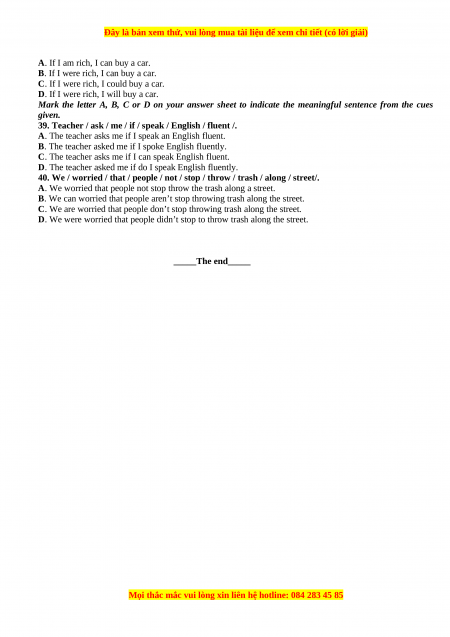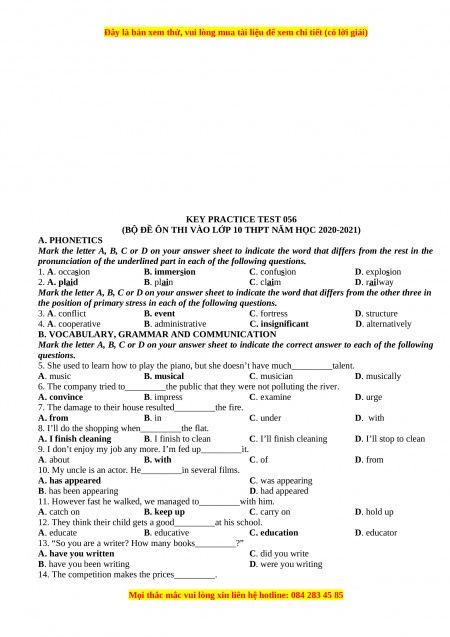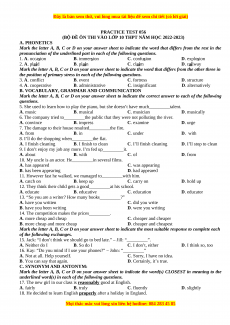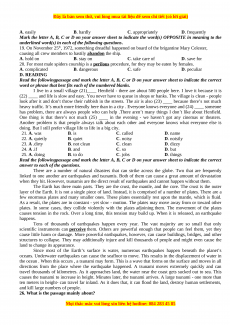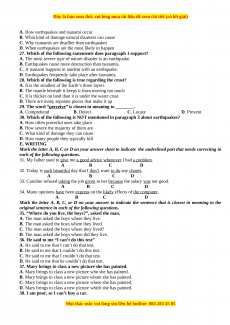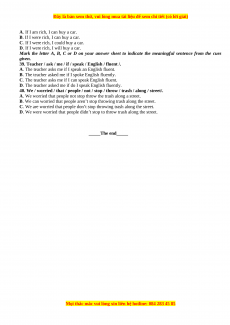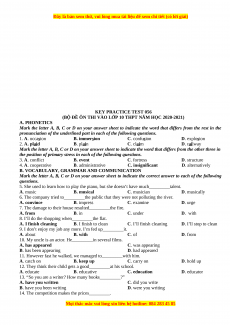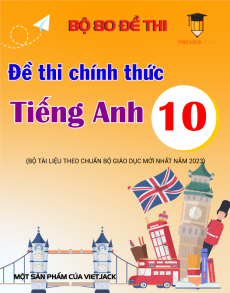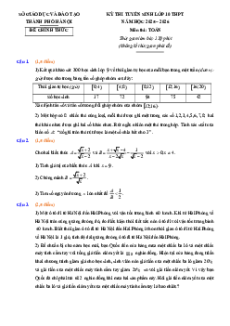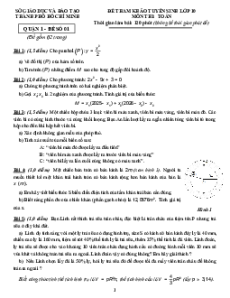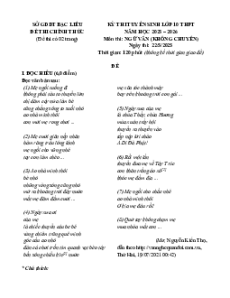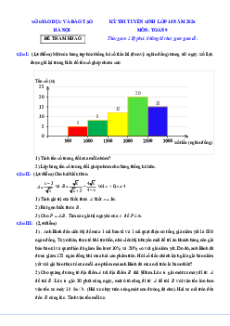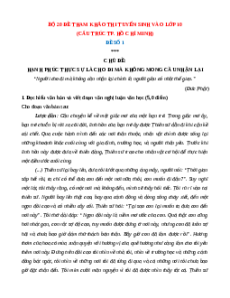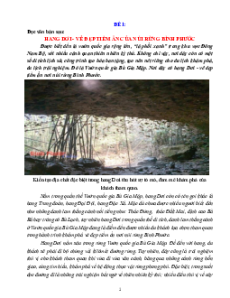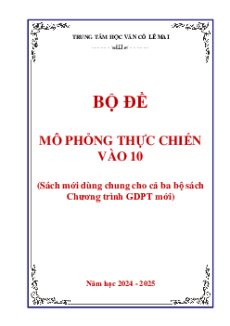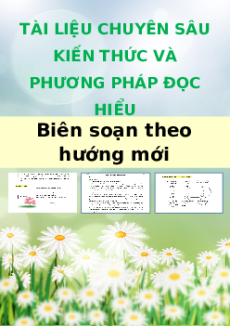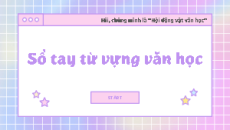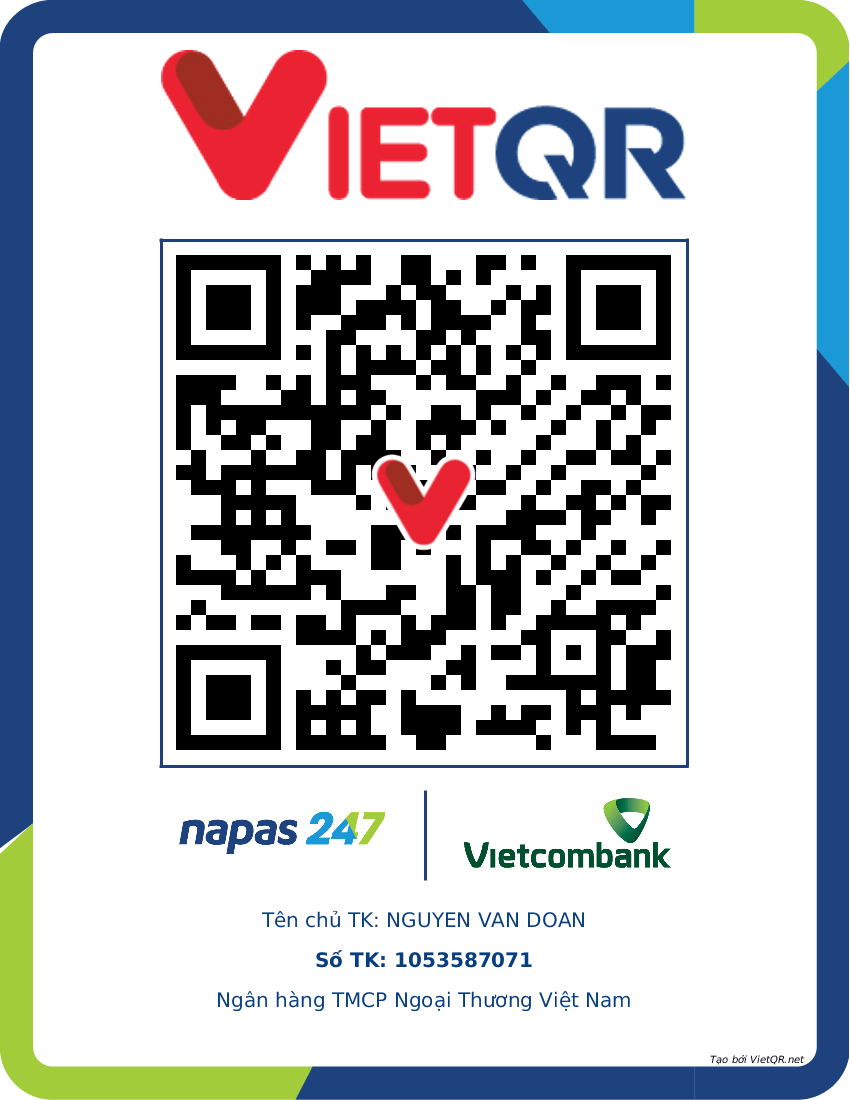PRACTICE TEST 056
(BỘ ĐỀ ÔN THI VÀO LỚP 10 THPT NĂM HỌC 2022-2023) A. PHONETICS
Mark the letter A, B, C or D on your answer sheet to indicate the word that differs from the rest in the
pronunciation of the underlined part in each of the following questions.
1. A. occasion B. immersion C. confusion D. explosion 2. A. plaid B. plain C. claim D. railway
Mark the letter A, B, C or D on your answer sheet to indicate the word that differs from the other three in
the position of primary stress in each of the following questions. 3. A. conflict B. event C. fortress D. structure 4. A. cooperative B. administrative C. insignificant D. alternatively
B. VOCABULARY, GRAMMAR AND COMMUNICATION
Mark the letter A, B, C or D on your answer sheet to indicate the correct answer to each of the following questions.
5. She used to learn how to play the piano, but she doesn’t have much_________talent. A. music B. musical C. musician D. musically
6. The company tried to_________the public that they were not polluting the river. A. convince B. impress C. examine D. urge
7. The damage to their house resulted_________the fire. A. from B. in C. under D. with
8. I’ll do the shopping when_________the flat. A. I finish cleaning B. I finish to clean
C. I’ll finish cleaning D. I’ll stop to clean
9. I don’t enjoy my job any more. I’m fed up_________it. A. about B. with C. of D. from
10. My uncle is an actor. He_________in several films. A. has appeared C. was appearing B. has been appearing D. had appeared
11. However fast he walked, we managed to_________with him. A. catch on B. keep up C. carry on D. hold up
12. They think their child gets a good_________at his school. A. educate B. educative C. education D. educator
13. “So you are a writer? How many books_________?” A. have you written C. did you write
B. have you been writing D. were you writing
14. The competition makes the prices_________. A. more cheap and cheap C. cheaper and cheaper
B. more cheap and more cheap D. cheaper and cheapest
Mark the letter A, B, C or D on your answer sheet to indicate the most suitable response to complete each of the following exchanges.
15. Jack: “I don’t think we should go to bed late.” – Jill: “_________”. A. Neither do I B. So do I C. I don’t, either D. I think so, too
16. Kay: “Do you mind if I use your phones?” – John: “_________”
A. Not at all. Help yourself.
C. Sorry, I have no idea.
B. You can say that again.
D. Certainly, it’s true. C. SYNONYM AND ANTONYM:
Mark the letter A, B, C or D on your answer sheet to indicate the word(s) CLOSEST in meaning to the
underlined word(s) in each of the following questions.
17. The new girl in our class is reasonably good at English. A. fairly B. truly C. fluently D. slightly
18. He decided to learn English properly after a holiday in England.
A. easily B. hardly C. appropriately D. frequently
Mark the letter A, B, C or D on your answer sheet to indicate the word(s) OPPOSITE in meaning to the
underlined word(s) in each of the following questions.
19. On November 25th, 1972, something dreadful happened on board of the brigantine Mary Celester,
causing all crew members to hastily abandon the ship. A. hold on B. stay on C. take care of D. save for
20. For most male spiders courship is a perilous procedure, for they may be eaten by females. A. complicated B. dangerous C. safe D. peculiar D. READING
Read the followingpassage and mark the letter A, B, C or D on your answer sheet to indicate the correct
word or phrase that best fits each of the numbered blanks.
I live in a small village (21)____ Henfield - there are about 500 people here. I love it because it is
(22) ____ and life is slow and easy. You never have to queue in shops or banks. The village is clean - people
look after it and don’t throw their rubbish in the streets. The air is also (23) ____ because there’s not much
heavy traffic. It’s much more friendly here than in a city . Everyone knows everyone and (24) ____ someone
has problem, there are always people who can help .There aren’t many things I don’t like about Henfield.
One thing is that there’s not much (25) ____ in the evening - we haven’t got any cinemas or theaters.
Another problem is that people always talk about each other and everyone knows what everyone else is
doing. But I still prefer village life to life in a big city. 21. A. was B. is C. called D. name 22. A. quietly B. quiet C. noisy D. noisily 23. A .dirty B. not clean C. clean D. dizzy 24. A .if B. and C. so D. but 25. A. doing B. to do C. jobs D. things
Read the followingpassage and mark the letter A, B, C or D on your answer sheet to indicate the correct
answer to each of the questions.
There are a number of natural disasters that can strike across the globe. Two that are frequently
linked to one another are earthquakes and tsunamis. Both of them can cause a great amount of devastation
when they hit. However, tsunamis are the direct result of earthquakes and cannot happen without them.
The Earth has three main parts. They are the crust, the mantle, and the core. The crust is the outer
layer of the Earth. It is not a single piece of land. Instead, it is comprised of a number of plates. There are a
few enormous plates and many smaller ones. These plates essentially rest upon the mantle, which is fluid.
As a result, the plates are in constant - yet slow - motion. The plates may move away from or toward other
plates. In some cases, they collide violently with the plates adjoining them. The movement of the plates
causes tension in the rock. Over a long time, this tension may build up. When it is released, an earthquake happens.
Tens of thousands of earthquakes happen every year. The vast majority are so small that only
scientific instruments can perceive them. Others are powerful enough that people can feel them, yet they
cause little harm or damage. More powerful earthquakes, however, can cause buildings, bridges, and other
structures to collapse. They may additionally injure and kill thousands of people and might even cause the land to change its appearance.
Since most of the Earth’s surface is water, numerous earthquakes happen beneath the planet’s
oceans. Underwater earthquakes can cause the seafloor to move. This results in the displacement of water in
the ocean . When this occurs , a tsunami may form. This is a wave that forms on the surface and moves in all
directions from the place where the earthquake happened. A tsunami moves extremely quickly and can
travel thousands of kilometres. As it approaches land, the water near the coast gets sucked out to sea. This
causes the tsunami to increase in height. Minutes later, the tsunami arrives. A large tsunami - one more than
ten meters in height- can travel far inland. As it does that, it can flood the land, destroy human settlements,
and kill large numbers of people.
26. What is the passage mainly about?
A. How earthquakes and tsunami occur
B. What kind of damage natural disasters can cause
C. Why tsunamis are deadlier than earthquakes
D. When earthquakes are the most likely to happen
27. Which of the following statements does paragraph 1 support?
A. The most severe type of nature disaster is an earthquake.
B. Earthquakes cause more destruction than tsunamis.
C. A tsunami happens in tandem with an earthquake.
D. Earthquakes frequently take place after tsunamis.
28. Which of the following is true regarding the crust?
A. It is the smallest of the Earth’s three layers
B. The mantle beneath it keeps it from moving too much
C. It is thicker on land than it is under the water crust
D. There are many separate pieces that make it up
29. The word “perceive” is closest in meaning to ________. A. Comprehend B. Detect C. Locate D. Prevent
30. Which of the following is NOT mentioned in paragraph 3 about earthquakes?
A. How often powerful ones take place
B. How severe the majority of them are
C. What kind of damage they can cause
D. How many people they typically kill E. WRITING
Mark the letter A, B, C or D on your answer sheet to indicate the underlined part that needs correcting in
each of the following questions.
31. My father used to give me a good advice whenever I had a problem. A B C D
32. Today is such beautiful day that I don’t want to do any chores. A B C D
33. Caroline refused taking the job given to her because the salary was not good. A B C D
34. Many opinions have been express on the likely effects of the computer. A B C D
Mark the letter A, B, C, or D on your answer to indicate the sentence that is closest in meaning to the
original sentence in each of the following questions.
35. “Where do you live, the boys?”, asked the man.
A. The man asked the boys where they live.
B. The man asked the boys where they lived.
C. The man asked the boys where they lived?
D. The man asked the boys where did they live.
36. He said to me “I can’t do this test”
A. He said to me that I can’t do that test.
B. He said to me that I couldn’t do this test.
C. He said to me that I couldn’t do that test.
D. He said to me that he couldn’t do that test.
37. Mary brings to class a new picture she has painted.
A. Mary brings to class a new picture who she has painted.
B. Mary brings to class a new picture whom she has painted.
C. Mary brings to class a new picture where she has painted.
D. Mary brings to class a new picture which she has painted.
38. I am poor, so I can’t buy a car.
A. If I am rich, I can buy a car.
B. If I were rich, I can buy a car.
C. If I were rich, I could buy a car.
D. If I were rich, I will buy a car.
Mark the letter A, B, C or D on your answer sheet to indicate the meaningful sentence from the cues given.
39. Teacher / ask / me / if / speak / English / fluent /.
A. The teacher asks me if I speak an English fluent.
B. The teacher asked me if I spoke English fluently.
C. The teacher asks me if I can speak English fluent.
D. The teacher asked me if do I speak English fluently.
40. We / worried / that / people / not / stop / throw / trash / along / street/.
A. We worried that people not stop throw the trash along a street.
B. We can worried that people aren’t stop throwing trash along the street.
C. We are worried that people don’t stop throwing trash along the street.
D. We were worried that people didn’t stop to throw trash along the street. _____The end_____
Đề luyện thi vào 10 môn Tiếng anh năm 2023 có đáp án (Đề 56)
1.3 K
656 lượt tải
MUA NGAY ĐỂ XEM TOÀN BỘ TÀI LIỆU
CÁCH MUA:
- B1: Gửi phí vào TK:
1133836868- CT TNHH DAU TU VA DV GD VIETJACK - Ngân hàng MB (QR) - B2: Nhắn tin tới Zalo VietJack Official ( nhấn vào đây ) để xác nhận thanh toán và tải tài liệu - giáo án
Liên hệ ngay Hotline hỗ trợ: 084 283 45 85
Đề thi được cập nhật liên tục trong gói này từ nay đến hết tháng 6/2023. Chúng tôi đảm bảo đủ số lượng đề đã cam kết hoặc có thể nhiều hơn, tất cả có BẢN WORD, LỜI GIẢI CHI TIẾT và tải về dễ dàng.
Để tải tài liệu gốc về máy bạn click vào nút Tải Xuống ở trên!
Thuộc bộ (mua theo bộ để tiết kiệm hơn):
- Tailieugiaovien.com.vn giới thiệu bộ 80 đề luyện thi vào 10 môn Tiếng anh mới nhất năm 2022 - 2023 nhằm giúp Giáo viên có thêm tài liệu tham khảo đề luyện thi Tiếng anh ôn luyện vào 10.
- File word có lời giải chi tiết 100%.
- Mua trọn bộ sẽ tiết kiệm hơn tải lẻ 50%.
Đánh giá
4.6 / 5(1311 )5
4
3
2
1
Trọng Bình
Tài liệu hay
Giúp ích cho tôi rất nhiều
Duy Trần
Tài liệu chuẩn
Rất thích tài liệu bên VJ soạn (bám sát chương trình dạy)
TÀI LIỆU BỘ BÁN CHẠY MÔN Tiếng Anh
Xem thêmTÀI LIỆU BỘ BÁN CHẠY Ôn vào 10
Xem thêmTài liệu bộ mới nhất

Đây là bản xem thử, vui lòng mua tài liệu để xem chi tiết (có lời giải)
PRACTICE TEST 056
(BỘ ĐỀ ÔN THI VÀO LỚP 10 THPT NĂM HỌC 2022-2023)
A. PHONETICS
Mark the letter A, B, C or D on your answer sheet to indicate the word that differs from the rest in the
pronunciation of the underlined part in each of the following questions.
As Bs Cs Ds
Aai Bai Cai Dai
Mark the letter A, B, C or D on your answer sheet to indicate the word that differs from the other three in
the position of primary stress in each of the following questions.
A B C D
A B C D
B. VOCABULARY, GRAMMAR AND COMMUNICATION
Mark the letter A, B, C or D on your answer sheet to indicate the correct answer to each of the following
questions.
!!!!!!!!!
A B C D
"#!!!!!!!!!
A B C D
$#!!!!!!!!!
A B C D
%& !!!!!!!!!
A& B& C& D&
'& ((& !!!!!!!!!
A B C D
)*+!!!!!!!!!
A
B
C
D
+,!!!!!!!!!
A B, C D
#,!!!!!!!!!
A B C D
-.+,!!!!!!!!!./
A
B
C
D
#,!!!!!!!!!
A
B
C
D
Mark the letter A, B, C or D on your answer sheet to indicate the most suitable response to complete each
of the following exchanges.
0,1-& ,/201-!!!!!!!!!/
A3& B& C& D&,
"41-5&./201-!!!!!!!!!/
A3+
B6
C&
D7
C. SYNONYM AND ANTONYM:
Mark the letter A, B, C or D on your answer sheet to indicate the word(s) CLOSEST in meaning to the
underlined word(s) in each of the following questions.
$#reasonably89
A B999999 C99999 D
%+8properly89
Mọi thắc mắc vui lòng xin liên hệ hotline: 084 283 45 85

Đây là bản xem thử, vui lòng mua tài liệu để xem chi tiết (có lời giải)
A9999999999 B999999999 C9999999 D:
Mark the letter A, B, C or D on your answer sheet to indicate the word(s) OPPOSITE in meaning to the
underlined word(s) in each of the following questions.
';3
'$*7
abandon
A B C, D
)<perilous9
A B C D
D. READING
Read the followingpassage and mark the letter A, B, C or D on your answer sheet to indicate the correct
word or phrase that best fits each of the numbered blanks.
&=>!!!!+?))&
=>!!!!6:,#?
, #=>!!!!
& 8,=>!!!!
# & ,+
; =>!!!!?
@,,
A&
A B C D
A: B: C D
A B C DBB
A B C D
A B C( D
Read the followingpassage and mark the letter A, B, C or D on your answer sheet to indicate the correct
answer to each of the questions.
#,#:
,:,A
+:,
#8##
8&&99#
#
@??#
&9(9#
,;C:,
# :, # (
9perceive9;
*:,
#(,
8 :,
D:,#
C#
:,@:,
,@,#
*@?
?@
,
26. What is the passage mainly about?
Mọi thắc mắc vui lòng xin liên hệ hotline: 084 283 45 85

Đây là bản xem thử, vui lòng mua tài liệu để xem chi tiết (có lời giải)
A9+:,
B9C,
C9C:,
D9C:,,
27. Which of the following statements does paragraph 1 support?
A9#:,
B98:,
C9@:,
D98:,:,
28. Which of the following is true regarding the crust?
A9&8
B9#,
C9&,
D#,9
29. The word “perceive” is closest in meaning to ________.
A97 B95 C9E D9F
30. Which of the following is NOT mentioned in paragraph 3 about earthquakes?
A9+,
B9+(
C9C,
D9+,
E. WRITING
Mark the letter A, B, C or D on your answer sheet to indicate the underlined part that needs correcting in
each of the following questions.
*&
A B C D
#&
A B C D
7,(
A B C D
*,
A B C D
Mark the letter A, B, C, or D on your answer to indicate the sentence that is closest in meaning to the
original sentence in each of the following questions.
35. “Where do you live, the boys?”, asked the man.
A#,
B#,
C#,.
D#,
36. He said to me “I can’t do this test”
A+&
B+&
C+&
D+
37. Mary brings to class a new picture she has painted.
A*
B*
C*
D*
38. I am poor, so I can’t buy a car.
Mọi thắc mắc vui lòng xin liên hệ hotline: 084 283 45 85

Đây là bản xem thử, vui lòng mua tài liệu để xem chi tiết (có lời giải)
A&&&
B&&&
C&&&
D&&&
Mark the letter A, B, C or D on your answer sheet to indicate the meaningful sentence from the cues
given.
39. Teacher / ask / me / if / speak / English / fluent /.
A#,&,8
B#,&,8
C#,&,8
D#,&,8
40. We / worried / that / people / not / stop / throw / trash / along / street/.
AC
BC
CC
DC
_____The end_____
Mọi thắc mắc vui lòng xin liên hệ hotline: 084 283 45 85

Đây là bản xem thử, vui lòng mua tài liệu để xem chi tiết (có lời giải)
KEY PRACTICE TEST 056
(BỘ ĐỀ ÔN THI VÀO LỚP 10 THPT NĂM HỌC 2020-2021)
A. PHONETICS
Mark the letter A, B, C or D on your answer sheet to indicate the word that differs from the rest in the
pronunciation of the underlined part in each of the following questions.
As B. immersion Cs Ds
A. plaid Bai Cai Dai
Mark the letter A, B, C or D on your answer sheet to indicate the word that differs from the other three in
the position of primary stress in each of the following questions.
A B. event C D
A B C. insignificant D
B. VOCABULARY, GRAMMAR AND COMMUNICATION
Mark the letter A, B, C or D on your answer sheet to indicate the correct answer to each of the following
questions.
!!!!!!!!!
A B. musical C D
"#!!!!!!!!!
A. convince B C D
$#!!!!!!!!!
A. from B C D
%& !!!!!!!!!
A. I finish cleaning B& C& D&
'& ((& !!!!!!!!!
A B. with C D
)*+!!!!!!!!!
A. has appeared
B
C
D
+,!!!!!!!!!
A B. keep up C D
#,!!!!!!!!!
A B C. education D
-.+,!!!!!!!!!./
A. have you written
B
C
D
#,!!!!!!!!!
Mọi thắc mắc vui lòng xin liên hệ hotline: 084 283 45 85
